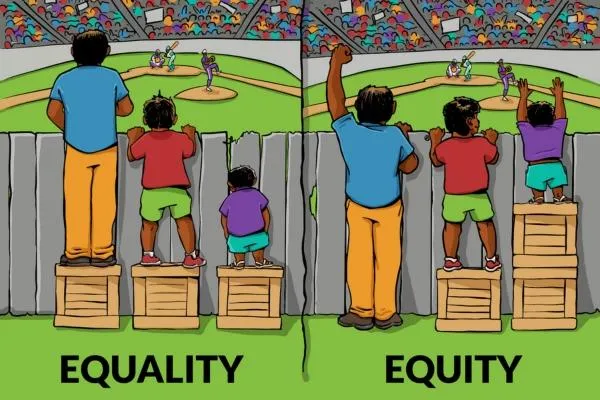
Equality vs Equity
Understanding the Difference Between Equality and Equity
Imagine you're at a concert with a tall friend. You both want a clear view of the stage, but you're much shorter. If you're given identical boxes to stand on, that's equality—your tall friend gets an even better view, while you’re still struggling to see above the crowd. Now, if you're given a taller box than them, bringing you to the same eye level, that's equity—ensuring both of you can enjoy the performance equally.
Or take this example: A school gives every student a pair of shoes. In an equality scenario, everyone gets the same size. That means Big-Foot Bobby is in pain squeezing into shoes too small for him, while Tiny Tina is drowning in shoes too large for her. In an equity scenario, each student receives the correct size, ensuring comfort and functionality for all.
Why Women Have Been Fighting for Equality—And Why It’s Not Enough
For decades, women have been fighting for equality – equal rights, equal pay, equal opportunities. And while these battles have been crucial, maybe we've been aiming at the wrong target all along.
The truth—however difficult it may be to accept—is that women and men are fundamentally different. We're not talking about outdated stereotypes or limiting beliefs. We're talking about major biological and psychological differences.
Trying to apply the same one-size-fits-all approach to both genders is like forcing everyone into the same shoe size. It doesn’t work because it ignores the unique challenges and strengths of women.
Equity: The Solution That Works With, Not Against, Our Differences
What we should be striving for instead of equality is equity—a system that recognizes differences and provides solutions that allow everyone to succeed. We don't need men and women to be treated exactly the same. We need men and women to each be given what they need to have equal opportunities of success.
In the workplace, equity could mean flexible hours that accommodate caregiving responsibilities, which still disproportionately fall on women.
In healthcare research, it means studying how diseases or treatments specifically affect women (and moreover, women at different places in their cycles), rather than defaulting to results based on male experiences.
In education, it involves teaching methods that align with the natural learning styles of both boys and girls.
Final Thoughts: The Path Forward
Switching to an equity model isn’t so that we start to favor women over men. It’s about acknowledging that the current system was largely designed by and for men—and making adjustments so that women can excel too.
It's time to stop trying to squeeze into shoes that don’t fit. Instead, we should push for custom solutions that allow both men and women to thrive.
Are you ready to join the conversation?
At The Intimate Instinct, we explore the complexities of sexuality, intimacy, and relationships through the psychological lens of masculinity & femininity and the physiological lens of hormones and neurotransmitters—all with the goal of teaching you practical insights to deepen your relationships. If you’re curious about these topics, and about becoming the best individual and partner that you can be, consider joining our women’s group. We gather online, weekly, as a small group to have thought-provoking discussions, share stories, and connect with one another.
👉 We review applications on a rolling basis—new cohorts begin approximately every three months. There is no cost or commitment to apply and once you enroll, you have 20 days to request a full refund if you're not satisfied. So what are you waiting for?! Apply now to join the conversation!
